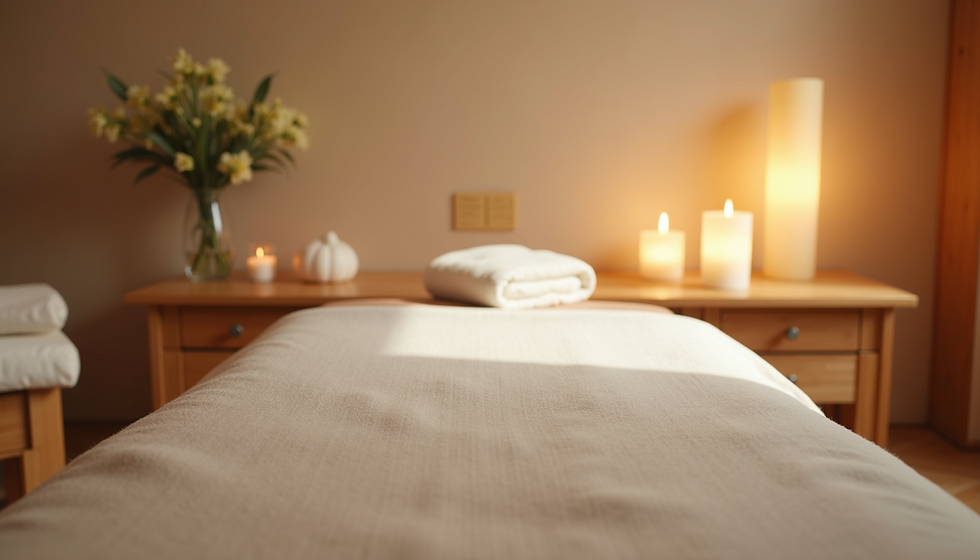How Massage Therapy Can Improve Physical Performance
- Ludovic Aristhene
- Sep 5
- 4 min read
Updated: Sep 8
Massage therapy is a powerful tool that can significantly enhance physical performance. Whether you are an athlete, a fitness enthusiast, or someone who simply wants to maintain a healthy body, incorporating massage therapy into your routine can offer numerous benefits. This article explores how massage therapy works, its impact on the body, and practical advice on integrating it into your lifestyle for optimal results.
Understanding Massage Therapy and Its Role in Physical Performance
Massage therapy involves the manipulation of soft tissues in the body, including muscles, tendons, and ligaments. This practice helps to relieve tension, improve circulation, and promote relaxation. When it comes to physical performance, massage therapy can:
Reduce muscle soreness and stiffness
Enhance flexibility and range of motion
Accelerate recovery after intense exercise
Prevent injuries by addressing muscle imbalances
For example, after a long run or an intense gym session, a massage can help flush out lactic acid buildup, which is often responsible for muscle fatigue and soreness. This allows the muscles to recover faster and perform better in subsequent workouts.

In addition to physical benefits, massage therapy also supports mental well-being. Reducing stress and anxiety through massage can improve focus and motivation, which are crucial for maintaining a consistent training regimen.
The Science Behind Massage Therapy and Physical Performance
Massage therapy works by stimulating the nervous system and increasing blood flow to targeted areas. This increased circulation delivers oxygen and nutrients to muscles, which helps repair damaged tissues and remove metabolic waste products. The mechanical pressure applied during massage also helps break down adhesions and scar tissue, improving muscle elasticity.
One of the key physiological effects of massage is the reduction of cortisol, a stress hormone that can negatively impact muscle recovery and immune function. Lower cortisol levels mean the body can heal more efficiently and maintain a stronger immune response.
Moreover, massage therapy activates the parasympathetic nervous system, which promotes relaxation and reduces muscle tension. This effect is particularly beneficial for athletes who experience tightness or spasms after training or competition.

By regularly incorporating massage therapy, athletes can experience improved muscle function, better joint mobility, and enhanced overall performance.
How Often Should You Go for a Sports Massage?
The frequency of sports massage depends on several factors, including the intensity of your training, your physical condition, and your specific goals. Here are some general guidelines:
For regular maintenance: Once every 3 to 4 weeks is sufficient to keep muscles healthy and prevent injuries.
During intense training periods: Weekly sessions can help manage muscle fatigue and improve recovery.
Post-competition or injury: More frequent sessions, such as 2 to 3 times per week, may be necessary to aid healing and reduce inflammation.
It is important to listen to your body and adjust the frequency accordingly. Consulting with a qualified massage therapist can help tailor a schedule that fits your needs.

Remember, consistency is key. Regular massage therapy sessions can provide cumulative benefits that enhance your physical performance over time.
Practical Tips for Maximising the Benefits of Massage Therapy
To get the most out of massage therapy, consider the following tips:
Communicate clearly with your therapist: Share your goals, any pain points, and your training schedule. This helps the therapist focus on areas that need the most attention.
Stay hydrated: Drinking water before and after a massage helps flush out toxins released during the session.
Combine with other recovery methods: Use massage therapy alongside stretching, foam rolling, and proper nutrition for a holistic approach to recovery.
Schedule massages strategically: Plan sessions around your training and competition calendar to optimise recovery and performance.
Choose the right type of massage: Different techniques, such as deep tissue, Swedish, or sports massage, serve different purposes. Select the one that best suits your needs.
For those interested in learning more about the specific benefits of sports massage, this resource provides detailed insights into how targeted massage can support athletic performance and recovery.
Beyond Physical Performance: Additional Advantages of Massage Therapy
Massage therapy offers more than just physical benefits. It can also improve mental clarity, reduce anxiety, and enhance sleep quality. These factors indirectly contribute to better physical performance by supporting overall health and well-being.
For example, athletes who sleep well tend to have faster reaction times, better coordination, and improved endurance. Massage therapy can promote deeper, more restful sleep by relaxing the nervous system and reducing muscle tension.
Additionally, massage can help manage chronic pain conditions, which might otherwise limit physical activity. By addressing pain and discomfort, individuals can maintain a more active lifestyle and continue to improve their fitness levels.
Incorporating massage therapy into your routine is a proactive way to support both your body and mind, leading to sustained improvements in physical performance.
Massage therapy is a valuable addition to any physical training programme. By reducing muscle tension, enhancing circulation, and promoting relaxation, it helps athletes and active individuals perform at their best. Whether you are recovering from a tough workout or preparing for a competition, regular massage sessions can make a significant difference in your physical capabilities and overall well-being.



Comments